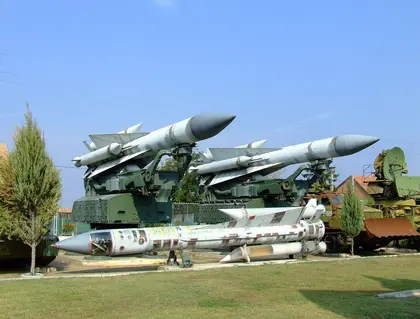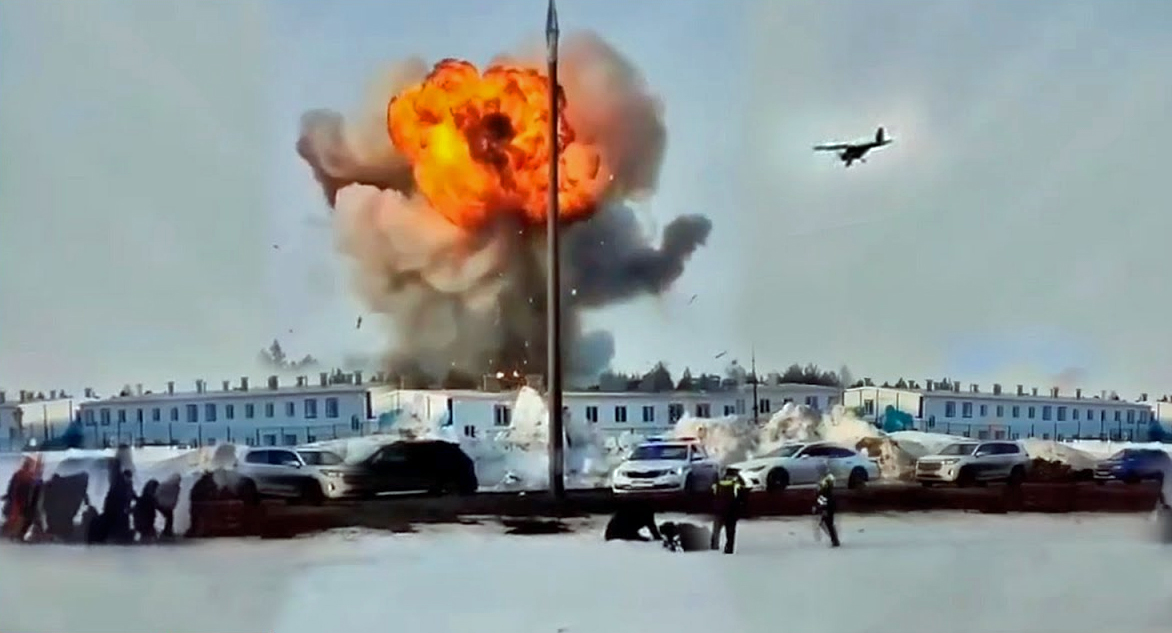To take down a Tu-22 and two A-50s , Ukraine likely used 1960s Soviet-era S-200 [NATO: SA-5] air defense missiles systems designed to shoot down high-altitude strategic bombers and spy planes.
They may have been upgraded, or Kyiv may have adopted new tactics, or both.
JOIN US ON TELEGRAM
Follow our coverage of the war on the @Kyivpost_official.
In the last four months, Ukraine has made significant progress in countering the Kremlin’s strategic aviation. Unlike previous incidents in which Russian bombers were only damaged or destroyed while on their base airfields, the Ukrainian air defense forces have showcased a new level of expertise by successfully shooting down enemy strategic aircraft directly in the air.
In January 2024, the air defense forces of Ukraine destroyed a Russian A-50U long-range radar detection aircraft and seriously damaged an Il-22M. The Il-22M is believed to have served as a repeater by the Russians. Unfortunately, the enemy managed to land the plane, which had suffered significant damage to the tail section of the fuselage. On the evening of February 23, another Russian A-50 aircraft was shot down during a combat mission over the Sea of Azov.
On the morning of April 19, 2024, the Russian Tu-22M3 supersonic strategic bomber, carrying Kh-22 and Kh-32 missiles, became the prey of the Ukrainian Air Force and the HUR. Ukraine claims that in all these instances, the dated Soviet S-200 anti-aircraft unit was used.
S-200 Angara
The S-200 [NATO: SA-5 Gammon] is a long-range anti-aircraft missile system developed in the USSR in the 1960s, which could hit air targets at up to 160 km in its early versions.

ISW Russian Offensive Campaign Assessment, December 24, 2024
The history of the S-200 began in 1958 when the Soviet Union felt the need for new air defense systems capable of destroying targets at a much greater distance than the S-75 and S-125 complexes available at that time (the maximum range of which was only 45 km). The new S-200 system was supposed to counter enemy strategic bombers and reconnaissance aircraft, the main ones at that time being the US B-52, U-2, and SR-71.
Unlike previous complexes, which used the command method of controlling the missile, Soviet designers integrated into the S-200 a fundamentally new guidance system using semi-active radar homing. This revolutionary step made the missile, as it could now capture and engage a target without the need for direct control commands from the ground station. For this, it was only necessary to illuminate the target with a special continuous-wave radar.
Versions of the S-200 system
During its time, the S-200 system underwent four modernizations, the most famous of which were the S-200V Vega, the S-200M Vega-M and the basic version of the S-200 Angara. With each modification, missile and guidance were improved, increasing the accuracy of the system.
In the S-200V Vega, the range was increased from 160 to 180 km. The next version, the S-200M Vega-M, could destroy targets at 240-255 km. The Vega-M modification included changes not only to the missile, but also to the ground station and the launcher.
The upgraded version of the S-200D Dubna defense system is worth mentioning. It was designed to use new missiles capable of hitting targets up to 300 km away. However, the Soviet military leaders rejected it for service due to its incompatibility with the missiles used in other versions of the S-200. As a result, only 14 units of the Dubna were produced, and they were later disposed of.
All missiles used in the S-200 are unified. This means that newer modifications of the system are backward-compatible with missiles developed earlier. The system can launch 5B21, 5B21A, 5B21P, 5B28, and even 5B28N missiles with a nuclear warhead. The characteristics of these missiles are generally similar, but they have been improved over time, focusing on increasing the flight range and improving its guidance. The most common missile is the 5B28, which was an extensive modernization of the 5B21. It was produced later than other versions so a certain number of 5B28 rockets have survived until today.
The 5B28 missile is designed to destroy targets flying at speeds of up to 3,500 km/h at altitudes from 300 m to 40 km. The maximum damage range of this missile is 255 km; however, with the range increase, the probability of a hit drops significantly. The nominal kinematic range is about 300 km, and the warhead mass is 217 kg.
How Ukraine shot down the Tu-22M3 and A-50
As the head of Ukraine’s Main Intelligence Directorate (HUR) Kyrylo Budanov reported, the Tu-22M3 bomber was shot down from a distance of 308 kilometers.
He shared details of the successful operation to eliminate the Tu-22M3. According to him, the Ukrainian air defense waited at the frontline for a week, anticipating the area the enemy aircraft would appear.
Both A-50s were shot down from a considerable distance. The first plane was destroyed 170 kilometers away from the launcher, and the second one was shot down at more than 200 km.
The recent destruction of Russian aircraft by Ukrainian air defense forces at distances of 308, 170, and 200 km has caused a significant response. To put it into perspective, the American Patriot complex has a nominal range of 150-160 km. Therefore, it is unlikely that the Armed Forces could have shot down these planes from air defenses provided to Ukraine by its Western allies. Most likely, Ukraine upgraded the outdated S-200 systems and missiles it inherited from the Soviet Union.
The S-200 anti-aircraft missile systems were decommissioned in Ukraine in 2013. The official reason was that they were becoming obsolete and had high maintenance costs. Those were the days when Viktor Yanukovych’s regime ruled the country, and Pavlo Lebedev was the Minister of Defense. Lt. Gen. Ihor Romanenko, a former deputy chief of the General Staff, recalls that he and some other military personnel tried to keep the S-200 in service; however, the political leadership of the time decided to write them off anyway.
It’s possible that even then, in 2013, on the eve of Russia’s occupation of Crimea and parts of the eastern regions of Ukraine, there was a deliberate weakening of Ukraine’s defense capabilities. In May 2020, Pavlo Lebedev, the former Minister of Defense, was charged in absentia by the Pechersk Court in the case of the shooting of people on Maidan in February 2014.
But let's get back to the S-200: the decommissioned air defense systems unexpectedly got a new lease on life during Russia’s full-scale war against Ukraine.
It is important to note that none of the S-200 modifications developed in the USSR could boast a range of 308 km. The longest range had the S-200D Dubna, reaching up to 300 km. However, these systems have been destroyed and are no longer in service in Ukraine. In addition, although the theoretical range of the 5B28 missile reaches 300 km, its accuracy significantly drops after 250 km.
The S-200 air defense system is not mobile like the S-300 and S-400 systems. The launchers of the S-200 are placed in stationary positions prepared in advance. However, in the case of the downing of the Tu-22M3 aircraft, it is possible that the launcher was placed on wheels. Had it not been made mobile, preparing stationary positions for launchers and S-200 ground stations would have inevitably attracted the attention of Russian intelligence.
The technical specifications of the upgraded S-200 missile are currently not disclosed.
It is presumed that to increase the flight range, the missile’s warhead was downsized to accommodate additional rocket fuel. Another possibility is that Ukraine has modernized the guidance system, eliminating the need for target illumination or manual control from the ground. During the final stage of flight, the missile could capture the target in a fully autonomous automatic mode.
It's also possible that other countries have contributed to the modernization process by providing modern electronic components for the missile.
One final option is that a more portable continuous-wave radar was taken to an area where the aircraft were expected to be operating and, via coordination with the launcher ,the portable radar illuminated the target end-game from a closer range near the missile flight timeout for final self-corrections by the unmodified missile guiding on the reflected signal reflected by the target.
You can also highlight the text and press Ctrl + Enter







